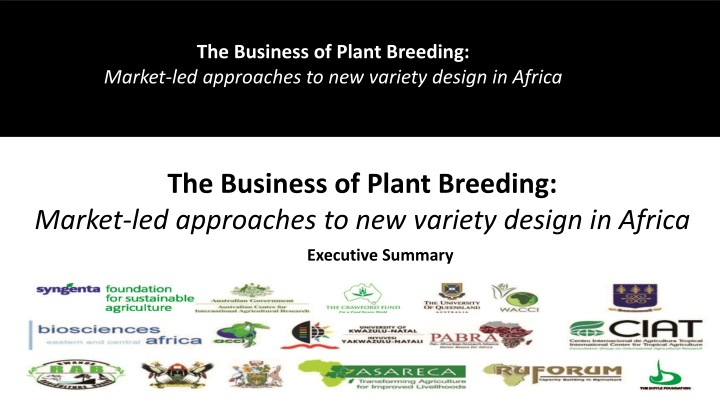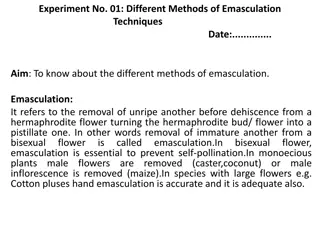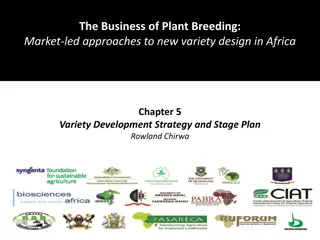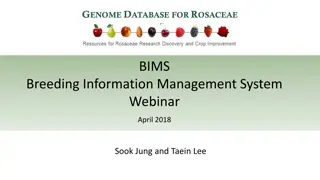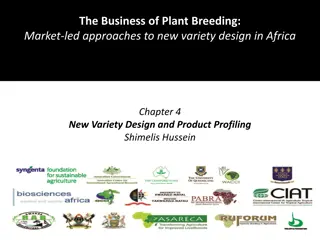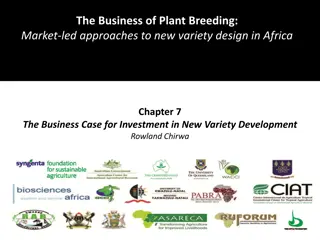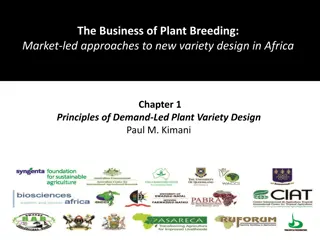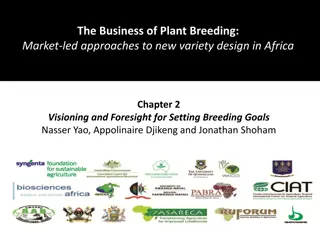Market-Led Approaches to Plant Breeding in Africa
Africa's agriculture is transitioning towards market-led systems, with smallholder farmers producing surpluses for growing demands. The focus is on quality, safety, and meeting market requirements to access expanding markets. Adoption of new crop varieties in Africa is around 35%, contrasting with higher rates in Asia and Latin America. The need is to understand clients' needs, develop new varieties, and make the business case for investments in variety development.
Download Presentation

Please find below an Image/Link to download the presentation.
The content on the website is provided AS IS for your information and personal use only. It may not be sold, licensed, or shared on other websites without obtaining consent from the author.If you encounter any issues during the download, it is possible that the publisher has removed the file from their server.
You are allowed to download the files provided on this website for personal or commercial use, subject to the condition that they are used lawfully. All files are the property of their respective owners.
The content on the website is provided AS IS for your information and personal use only. It may not be sold, licensed, or shared on other websites without obtaining consent from the author.
E N D
Presentation Transcript
Demand-Led Plant Breeding Training Manual The Business of Plant Breeding: Market-led approaches to new variety design in Africa The Business of Plant Breeding: Market-led approaches to new variety design in Africa Executive Summary
Overview Overview 1. Principles of demand-led plant variety design 2. Visioning and foresight for setting breeding goals 3. Understanding clients needs 4. New variety design and product profiling 5. Variety development strategy and stage plan 6. Monitoring, evaluation and learning 7. Making the business case for investment in new variety development
1. Principles of demand 1. Principles of demand- -led plant variety design led plant variety design Objectives 1. To understand the current status and challenges facing African agriculture 2. To review modern variety adoption in Africa 3. To understand the principles of demand-led breeding and similarities and differences with current practices
Transformation of Africas agriculture Africa s agriculture is at a tipping point; moving from subsistence systems to more market-led systems Smallholder farmers are generating surpluses of products to sell in local, national, regional and international markets Demand for products is rising with population growth, urbanization and changing lifestyles Anew breed of consumers focused, choosy and ready to pay for quality and safety of food
Transformation of Africas agriculture Enabling small scale farmers to access the expanding markets is a critical challenge facing policy makers Participation of smallholders in markets requires: Identification of market demands Developing products with suitable characteristics to meet market requirements
New Variety Adoption in Africa DIIVA study by Walker et al (2014) shows about 35% adoption of new varieties of 20 crops in 30 African countries over previous 15 years Compares with average of 60% new variety adoption in Asia and 80% in Latin America
Adoption of Modern Varieties of Food Crops in Africa Crop Total area (ha) % MVs Country observations 14 11 1 3 9 17 19 5 2 8 10 9 8 18 5 3 2 1 5 1 1 152 Adopted area (ha) 1,041,923 6,556,762 850,121 182,452 6,470,405 4,376,237 2,582,317 211,772 317,597 1,409,309 1,854,543 723,544 4,927,345 3,117,621 2,552,121 1,185,306 9,972,479 1,453,820 365,901 14,695,862 11,035,995 6,787,043 615,737 970,720 4,673,300 6,356,963 2,497,209 17,965,926 11,471,533 14,089,940 249,632 614,606 94,946 1,478,086 915,877 230,749 107,721,630 89.7 65.7 62.5 49.9 44.0 39.7 38.0 34.4 32.7 30.2 29.2 29.0 27.4 27.2 18.1 15.0 14.0 10.4 6.9 6.2 1.5 34.78 Soybean Maize WCA Wheat Pigeonpea Maize ESA Cassava Rice Potatoes Barley Yams Groundnut Bean Sorghum Cowpeas Pearl millet Chickpea Faba bean Lentils Sweetpotato Banana Field peas Total/weighted average 37,438 85,806 9,874 102,143 56,784 3,461 37,469,577 DIIVA project (2014)
Variety Adoption in Africa Constraints and issues in low adoption Awareness Availability Profitability Measuring adoption levels Pros and cons of various methods Quality of data is the key requirement Expert opinion, focus groups and survey data
Breeding Goals and Objectives Trait trade-offs Categorize and rank priority traits Categories of traits Plant traits; Tolerance to abiotic and biotic stresses; Consumer/market preferred traits; Balance of traits i.e. Basic traits all varieties must have; Traits to increase market share; and New traits not available in existing cultivars
Principles of Demand-Led Breeding What is demand-led plant breeding? Demand-led breeding is an approach that enables plant breeders to develop higher performing varieties that meet customer requirements and market demand It is based on six core principles Client Preferences Market Research Value Chain Market Trends and Drivers Multi- disciplinary Integration
Demand-led Breeding goes beyond Participatory Plant Breeding Participatory Plant Breeding demand-led breeding Highly localised activity End products are designed to suit specific environments The key actors in PPB are the farmers and the breeders PPB focuses on local needs, largely in subsistence food systems PPB focuses on local practises and harnesses expertise of farmers and breeders Seed distribution in PPB is limited to the locality of its operations Broader in scope and targets large areas or agro-ecological zones where the crop can be produced at national, regional and global levels Targets all actors in a value chain and innovation system Emphasizes markets, their demands, trends, and uses a broad range of tools such as market research, modern product promotion tools and value addition Seeks to combine the best practises from both public and private sectors Aims to disseminate seed of new varieties widely within national borders, regionally and globally
Summary Demand-led approaches aim to make the business of plant breeding in Africa more responsive to market demands Demand-led approaches go beyond farmer participatory breeding approaches to inclusivity of all the key stakeholders in the value chain Demand-led breeding retains emphasis on the value of the breeders eyes and experience
Summary An appropriate balance is required between using demand-led approaches and technology/innovation push to maximise market creation for new varieties Role of plant breeders is much more than just leading crossing or selection programmes The breeder must also be an integrator of inputs and be able to take on board information from a broad range of sources, including non-technical experts
2. Visioning and foresight for setting breeding goals 2. Visioning and foresight for setting breeding goals Objectives 1. To empower plant breeders and R&D leaders to consider future agricultural landscapes in Africa 2. To equip breeders with methodologies to design new varieties that will remain relevant and satisfy market demands over time 3. To identify drivers that may affect whether farmers adopt new varieties in the future
Africa at a Glance: Agricultural landscape Food supply vs. demand Demand growth is fastest in the world SSA population c. 800 million 220 million undernourished Demand Mean population growth in SSA is c. 3% (-ve Europe, 0.5% Rest of the World) Population size expected to double in 35 years Population growth is double in urban vs. rural areas
Reasons for the Low Productivity Input market constraints Seed laws/industry local fertilizer industry Distribution system Credit availability Poor access to markets (lack of access to resources/inputs) WEAK PRIVATE SECTOR Rapid Urbanization growth (lack of access to land, degradation of natural resources Low investment in agricultural research, training and extension services Agricultural constraints Infrastructure; land rights African crop diversity/uniqueness Lack of extension/various farming system Lack of storage Overall constraints War; corruption; governance; education; lack of country economies of scale Low inter-regional trade Highest Tariffs Source: J L Shoham
Strategies for Transforming African Agriculture Improving agricultural productivity Availability and widespread use of quality farm inputs and technologies, including crop biotechnologies Facilitating growth in agricultural markets and trade Investing in public infrastructure for agricultural growth Reducing rural vulnerability and insecurity Improving agricultural policy and institutions Foresight and visioning to meet market/consumers demands
Integrating foresight into new variety design Foresight methods are used to review existing variety designs or as a starting point to create new designs Every trait characteristic in each product profile should be analysed and a decision taken if the trait and benchmark is likely to remain relevant over time required for variety development
3. Understanding clients needs Objectives 1. To equip breeders with the knowledge and methods to understand clients and their value chains, their needs, what they prefer and are prepared to pay for in a new variety 2. To understand markets and the need, importance and principles of market research and best practices to guide the information gathering from clients and crop value chains to drive and validate new variety designs
Understanding Clients needs 1. Crops and their Uses 2. Clients and Stakeholders 3. Markets and Market Segments 4. Clients within Value Chains 5. Understanding Markets and Market Research
Simplified Tomato Value Chain in Ghana Market Segments Local seed Seed producers/ suppliers producers/farmer saved seeds (informal) Farmers Market Queens 1. Open market 2. Roadside grocery 3. Supermarkets Retailer 1. Hotels & Restaurants 2. Local households 3. Expatriates Consumers
Fresh Tomatoes, their Uses and Pricing Segments Type: Mini, amber plum Use: Salads and snacking Pricing: Premium price Type: Cherry (on the vine) Use: Salads Pricing: Mid-range price Type: Large tomatoes Use: Fresh sliced, cooking Pricing: Economy price
Clients within Value Chains Different clients in value chains have different requirements and often cannot all be satisfied with the same variety, especially when there are specialist properties required for processing Breeders should have regular contact with clients in all parts of the value chain and involve them in new variety design
Implications for the Role of the Breeder The business of breeding Demand led approaches require breeders to learn the business of plant breeding and be able to gather and assimilate information from multiple clients and sources within crop value chains Partnering and collaboration Breeders need to broaden their reach, influence and know-how beyond their technical competencies and to be able to manage collaborations and partnerships with both the public and private sectors
4. New variety design and product profiling Objectives 1. To understand the core method of product profiling to: - Characterize existing varieties used by farmers; and - Identify future properties important to clients and other stakeholders along the value chain 2. To understand how to create new designs and set benchmarks to meet client needs 3. To understand how to prioritize a range of traits using demand-led approaches and make trade-off decisions 4. To translate new variety designs into a practical breeding programme with clear goals and objectives
New Variety Design Target clients Define who the new variety is targeted to serve i.e. what market segment(s) Value chain needs Understand clients and stakeholders along the whole targeted value chain Crop uses Define all uses of the crop as food, feed, energy, propagation seed or other purposes Variety identity and descriptors Understand every facet of the crop plant, pre and post harvest and differences between varieties
New Variety Design and Product Profiles Key messages Up-to-date qualitative and quantitative market research data on clients needs are essential to make decisions A key aspect in the design (often overlooked) is the cost and feasibility of seed multiplication To understand and create an advocacy programme with government regulators to adapt current registration requirements to include new, market-led design features that offer additional benefits to farmers and consumers
Client and Market Importance The core goal for a demand-led breeder is to create a new variety that meets a client demand by either: - Improving design features within existing varieties, - or - Providing new benefits that will increase new varietal adoption The four main inputs required for new variety design are: Market research Variety performance Traits required Trait prioritization
What is a Product Profile? The name given to the full range of technical attributes of a new variety with quantitative measures Also called ideotype or product specification The best product profiles always set a target benchmark for the required performance of each trait; by comparisons vs. the performance of existing varieties and/or expressed on a numeric or photographic scale Trait descriptors/dictionaries are compiled and published by the CGIAR International Research Centers and national research intuitions
Creating a Product Profile Performance required (=, >, >=, >>) Trait Variety benchmark Trait category No Trait description 1 2 1 2 1 2 1 2 Crop yield Plant architecture Seed production Biotic stress Abiotic stress Crop handling, harvest, storage, transport Value chain clients, consumers, processors 1 2 1 2
Priority of Traits Important and challenging decision for every breeder Market evaluation for each trait has two dimensions 1. Differentiation Willingness to pay price premium Opportunity to grow market share 2. Market demand % growers/area that need this trait
Trait Prioritization Willingness to pay price premium 10 8 Opportunity to grow market share Niche opportunity Winning traits 6 Differentiation 4 Low potential Essential traits 2 0 20 80 100 60 40 Market demand % growers/area that need this trait
Trait Prioritization 10 Winning traits Niche opportunity Yield Plant architecture Biotic stress Abiotic stress Crop handling Consumer preference 8 Differentiation 6 4 Differentiation Willingness to pay price premium 2 Opportunity to grow market share Low potential Essential traits 0 20 80 100 60 40 Market demand % growers/area that need this trait
Translating Product Profiles into Breeding Objectives Product profile aligns with a set of measurable breeding goals and objectives Successful demand-led variety design and development creates new varieties that are fit-for-purpose, high quality, and feasible The breeding science and its technical and practical feasibilities depend on defined goals and objectives
Translating Product Profiles into Breeding Objectives New varieties are highly innovative and require new combinations of traits The new varieties are: Distinguishable (D), Uniform (U), Stable (S) and Novel (N) - meeting the DUSN trial requirements Product profiles may require some revisions to increase the probability of delivery Innovation and ease of delivery can be inversely correlated; Paradigm shifts may require supporting investigative science programmes and pre- breeding activities
How is Demand-led Variety Design Different from Current Practice? 1. Competitor product profiling - Analysis of characteristics of existing varieties and landraces and their differentiating characteristics at each stage in the value chain 2. New variety design A product profile is created that contains many traits and characteristics (typically > 40) with performance benchmarks to create breeding objectives 3. Quantitative benchmarks A target quantitative bench- mark for each trait for line progression to variety release 4. Trade-off decisions on traits A decision process to determine final variety design that takes account of client needs, technical feasibility and fiscal considerations
Implications for Role of the Breeder Variety identity In depth understanding about the full range of characteristics that comprise each variety and landrace used by clients Registration officials Early dialogue with registration officials to develop a detailed understanding about the variety registration processes and requirements Co-ordination and consultation Greater consultation and co-ordination time and liaison skills are needed to understand the needs of clients all along the value chain Communication skills - Demand-led breeders need to present new variety designs to a range of clients, non- technical professionals, government officials and investors
Challenges In the large private sector seed industry, Demand-driven product design successfully introduced into productive plant breeding programmes Combined with excellent science and technology, development rigor and appropriate awareness campaigns with farmers and customers, Leads to significant gains in adoption rates and market share of new varieties
Challenges The challenge is finding cost-effective ways to tailor demand- led approaches to new variety design, product profiling and success criteria into public sector and small seed company breeding programmes in developing countries Need to harness skills and cooperation of the private sector; and better understand tropical crop value chains and market trends Opportunities for new public and private sector partnerships to solve problems together
5. Variety development strategy and stage plan Variety development strategy and stage plan Objectives 1. Variety development strategy and stage plan: To enable plant breeders to construct a high quality, well-documented demand-led breeding strategy and a development stage plan, to enable good governance, rigorous decision-making and activity planning within a demand-led breeding project 2. Stakeholder engagement: To ensure the variety development strategy and stage plan allow for involvement of stakeholders at key decision points on: The design, development and release of new varieties; Enabling new varieties to reach farmers; and Provide feedback on product performance and farmer adoption
Variety Development Strategy A development strategy defines the core breeding goal and creates a framework for decision-making and investment The strategy analyses the external environment, defines problem and answers key questions on the product being developed: what , why , for whom and how ? The strategy has a broader scope than a development plan and considers the end product and adoption. It should precede preparing the development stage plan
Development Stage Plan A Stage Plan includes the following key activities: Development planning Variety design Breeding, testing and evaluation Variety registration and scale up Seed production Monitoring and evaluation at all stages of the variety development process
Demand-led Breeding Stage Plan Line progression decisions Investment Decision Product Launch Commercial Candidates Product discontinuation of specific products in specific market segments selected requiring characterization, scaling-up and regulatory approval Products that have completed discontinuation activities, and stock removed from inventories Initiation of research on germplasm aligned to the product concept Product concept Breeding & Selection Product Evaluation and Scale-up Life Cycle Management Proof of Concept Variety Design Early Late F Pre- A E C D H B G Discovery Discontinue Commercial Development Development Commercial Identification, characterization and selection of specific traits to be used Market research. Product prototype characterization and selection based on performance in replicated trials and wider evaluation Preparing for launch Stop sales Elimination of inventory Line Small plot screening of products as commercial prototypes Product sales Discovery Product profile creation. Development Investment case created. Development. Development and screening of product components or pre-products rather than products Launch Rapid Growth Peak Sales Sales Decline Modified version of Syngenta Seeds stage plan Key Phase Stage Gate decision point Stage Stage activities
Critical Path Analysis Diagram with Risk Dependencies Activity New variety breeding programme 9 10+ 2 3 8 1 4 5 6 7 Years Activity 1 Critical path Dependency risk Activity 2 Activity 3 Activity 4 Activity 5 Activity 6 Activity 7 Activity 8 Activity 9 Activity 10
Importance of Timelines and Critical Path Understand the timelines and associated costs to develop and register a new variety Clear understanding about critical paths and approaches to risk reduction Develop risk mitigation strategies Understand costs and rewards associated with risks Critical path analysis and pro-active risk management will help breeding team to develop new varieties that meet farmers and value chain needs in a timely and cost- effective manner
Demand-led Variety Registration Consumer traits and regulatory hurdles Demand-led breeding is complex and can take longer- so a smooth registration process is a key factor Regional harmonization may influence market size and subsequent investment decisions Demand-led variety registration may be influence by international regulations such as UPOV, breeders rights and national registration agencies
6. Monitoring, evaluation and learning 6. Monitoring, evaluation and learning Objectives (1) 1. Performance benchmarking: To enable breeders to devise a realistic performance assessment plan for their demand-led breeding programme so: (i) It is incorporated into strategies and stage plans for new variety design and engages with clients and stakeholders in the value chain; (ii) It develops key performance indicators tailored for new variety development and delivery of a demand-led breeding programme s goals and objectives
6. Monitoring, evaluation and learning 6. Monitoring, evaluation and learning Objectives (2) 2. Variety adoption and performance tracking (i) To enable breeders to appreciate the importance of variety adoption assessment in demand-led breeding (ii) To design pathways for monitoring progress in demand-led breeding with value chain clients, with defined responsibilities for the various actors (iii) To explore improved, low cost methods for variety tracking to assess adoption of new varieties
Monitoring Monitoring is a continuous observation and checking procedure on the progress of on-going breeding activities. Compares progress of activities against milestones and timelines for decisions in the stage plan Compares estimated and actual costs of the project against its approved budget The purposes of monitoring are: To support reaching the milestones and targets set for the project in a timely manner; To determine if corrective action is required to solve emerging problems or any delays; To identify improvements that need to made to the stage plan
